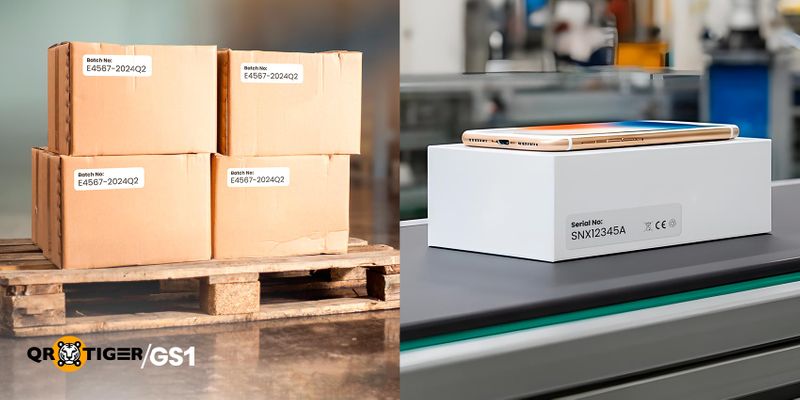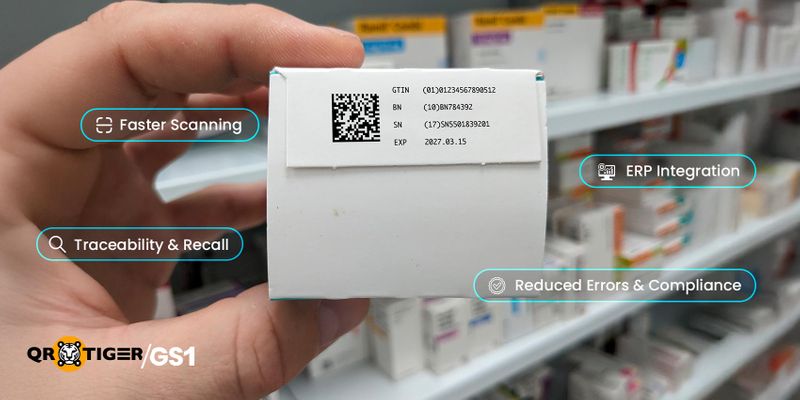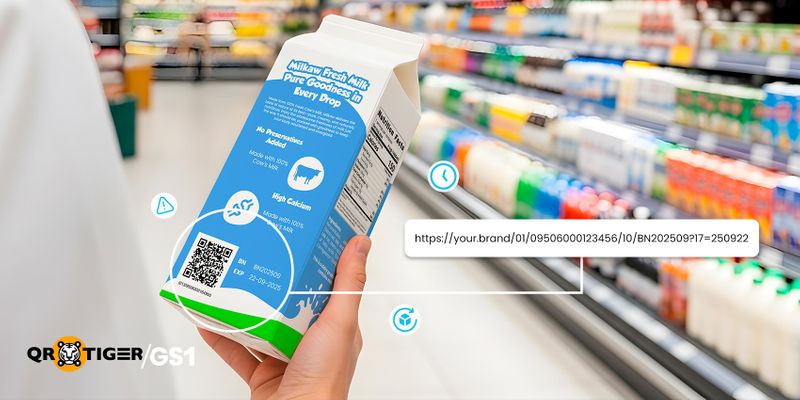Understanding Batch Number and Serial Number in the Supply Chain

Traceability is essential for ensuring product safety, quality, and accountability in global supply chains. It allows businesses to track the movement of goods from origin to destination, helping identify where and when a product was made, packed, or shipped.
This visibility is crucial across industries because errors can lead to expensive recalls or regulatory issues.
Unique identifiers such as batch number and serial number play a key role in this process. While they are called "numbers," they are often alphanumeric codes that can include letters, numbers, and other characters to encode specific information.
These identifiers support faster recalls, better inventory control, and product compliance with international standards like U.S. DSCSA (Drug Supply Chain Security Act) and ISO 22005 (Traceability in the feed and food chain), making supply chains more resilient and trustworthy.
This blog discusses the roles of these identifiers in supply chains, differences between them, and the benefits of embedding them in 2D barcodes.
Table of Contents
What Is a Batch Number?
A batch number (B/N) is an identifier assigned by a manufacturer to a group of products under the same conditions, during a specific period. It helps identify and trace products with identical production characteristics, thus simplifying quality monitoring and recall management.
These identifiers ensure consistency and accountability in regulated industries. They are widely used in pharmaceuticals, food, cosmetics, and chemical manufacturing to track production lots, validate product compliance, and respond quickly to safety issues.
In many of these sectors, expiry dates are also assigned at the batch level, meaning every product in the same batch carries the same expiration date.
Typically, you will find them on product labels, packaging, and invoices; they’re also recorded in Enterprise Resource Planning (ERP) systems.
The terms batch number and lot number are usually used to mean the same thing.
In some industries, a batch can mean one specific production run, while a lot can mean a larger group that may include several batches. This distinction isn’t universal, and many regulators and companies treat the terms as synonyms.
The code printed on the label will almost always be labeled as either "Batch No." (B/N), "Lot No." (L/N), or simply "Lot/Batch" or "Code."
What Is a Serial Number?
A serial number (S/N) refers to a unique identifier allocated to an individual product, enabling it to be distinguished from all other units of the same model or product type. Since it is a unique identifier for each product, no two products carry the same serial number. It facilitates unit-level traceability.
They are essential for tracking product history, usage, and ownership throughout its lifecycle.
They are commonly used in medical devices, electronics, machinery, and luxury goods, allowing manufacturers to trace the authenticity and origin of a specific product. They support authenticity checks, warranty verification, theft deterrence, and service or maintenance tracking.
Typically, you will find S/N printed directly on the product, included in warranty cards or manuals, and stored in ERP or inventory systems. For example, each smartphone carries its own serial number, helping service centers verify warranty status and track repairs.
Key differences between a batch number and serial number
A batch number and serial number differ significantly in terms of the aspects discussed below.
| Comparison Aspect | Batch Number | Serial Number |
| Purpose | To support production traceability, quality control, and recall tracking | To enable item-level tracking, lifecycle monitoring, and warranty management |
| Usage Context | Used when many items are made the same way at the same time | Used when each item needs to be tracked individually |
| GS1 Application Identifier | AI (10) | AI (21) |
| Inventory Management | Simplifies bulk tracking | Facilitates precise tracking and control of individual units |
| Regulatory Relevance | Required for batch-level compliance and audit trails | Required for high-value or high-risk item traceability |
Having a batch number does not mean a product cannot also have a serial number. The two can work side by side, serving different but complementary purposes.
Individually:
Batch numbers group items made the same way at the same time, which makes it easier to handle recalls, monitor quality, and manage stock in bulk.
Serial numbers give each product its own code, which helps track ownership, warranty, repairs, and authenticity.
Together:
When both are used, companies can trace a product at two levels: the batch it came from and the individual unit itself. For example, in pharmaceuticals, the batch number shows which lot of medicine the tablet belongs to, while the serial number shows which exact pack or box it is. This double layer strengthens traceability and compliance.
Past: The Issues with Manual Batch and Serial Number Tracking
Manual tracking of these identifiers introduces risks to supply chain efficiency and data integrity.
In the past, batch and serial numbers were only visible as printed text on packaging. Even when a product carried a 1D barcode, that code contained only the product identifier, not batch or serial details. Staff had to manually read and record these identifiers when checking inventory or handling stock rotation, often leading to errors, delays, and higher labor effort.
Manual entry: Manually entering batch and serial numbers into spreadsheets or ERP systems can pose data integrity issues. Human errors such as duplications, typos, or omissions can happen, especially when handling large volumes of products.
Such errors can reduce inventory accuracy, delay shipments, and compromise traceability. Manual processes lack real-time validation, delaying the detection of errors until they become critical.
Visual-only inspection: Relying only on printed batch or serial numbers for visual inspection means that there may be errors in quality control and makes recalls harder. Labels can smudge, fade over time, or be hard to read, especially in warehouses or retail stores.
Visual checks are time-consuming and can involve errors, making audits and product verification inefficient.
Here are the challenges faced in manual tracking:
- In manual tracking systems, there is limited integration between suppliers, retailers, and departments. This makes it hard to spot the problems and respond quickly during recalls or compliance checks.
- Audits take longer when data has to be matched manually across systems that are not interconnected.
Present: Embedding in 2D Barcodes
Today, batch numbers and serial numbers no longer need to be read manually from packaging. They can be embedded directly into 2D barcodes such as GS1 Digital Link QR code or DataMatrix. Unlike traditional 1D barcodes that carry only the product identifier, 2D barcodes have more than enough capacity to include additional details.
To do this properly, in a way that’s easy to understand, machine-readable, and globally standardized, the data is encoded using GS1 Application Identifiers (AIs). Think of AIs as small tags that tell you what the number after them means.
- (10) = Batch or Lot Number
- (21) = Serial Number
There are many more AIs, each dedicated to a specific type of information.
There are two main approaches to encoding these identifiers:
1. Element String (Traditional GS1 Syntax)
This method uses GS1 Application Identifiers (AIs). Each piece of information is tagged with an AI, creating a compact string that systems can decode.
Example:
(01)09506000123456(17)250930(10)BN4567(21)SN4280
2. GS1 Digital Link (Web-Enabled Format)
This method turns product identifiers into a URL. Scanning the barcode provides the same structured data for systems but also opens a web page for people using smartphones.
https://your.brand/01/09506000123456/10/BN4567/21/SN4280
Syntax is important for a 2D barcode to be readable by scanners. While many 2D barcode generators are available, most are freeform, meaning they simply let you type in text without enforcing GS1 rules.
This can lead to codes that look correct but fail in real-world scanning. For ease of use, it’s better to choose a solution that guides you on properly encoding your information, such as QR Tiger’s GS1 QR code generator.
Benefits of Embedding Batch and Serial Numbers

Adding batch and serial numbers to GS1 2D barcodes helps businesses track products better, work faster, and follow safety rules.
Faster scanning and data capture: Embedding these identifiers into machine-readable formats like GS1 QR code or GS1 DataMatrix supports automated data capture. This enables swift and accurate scanning at every point in the supply chain.
This reduces dependence on manual entry and speeds up processes such as receiving, shipping, and point of sale (POS) transactions.
Smooth integration with ERP and inventory systems: When these identifiers are embedded in standardized formats, for example, QR codes powered by GS1 Digital Link, they can be easily integrated into ERP platforms and inventory systems.
It allows quick updates to stock and shipping info, so different departments can work together better. This ensures consistent data flow and reduces reconciliation efforts.
Enhanced traceability and recall efficiency: With embedded identifiers, businesses can accurately trace products from origin to end users. If a product recall happens, businesses can quickly find the affected items using these identifiers, helping keep customers safe.
Reduced manual errors and improved compliance: The automated capture and recording of these numbers significantly reduces the risk of human error, such as incorrect data entry or mislabeling.
This improves data accuracy and supports product compliance with industry regulations, including those from ISO (International Organization for Standardization), FDA, and EU authorities. GS1 standards help ensure that product identification is consistent, easy to track, and aligned with global best practices.
Real-World Applications
Batch and serial numbers are most effectively used when embedded in 2D barcodes. Instead of being printed only as text, they can be scanned instantly across the supply chain, a practice already common in many industries.
Pharmaceuticals
In this industry, batch numbers help trace production lots, whereas serial numbers enable item-level identification of individual packages or vials. GS1 DataMatrix barcodes, which can encode both identifiers, are used to meet regulatory requirements like the EU Falsified Medicines Directive and U.S. DSCSA.
These barcodes allow automated scanning at each stage, from manufacturing to dispensing. This ensures accurate product traceability in the supply chain, reducing counterfeiting and supporting targeted recalls.
Electronics
Serial numbers embedded in GS1-compliant 2D barcodes are essential for tracking individual electronic devices throughout their lifecycle. Retailers and manufacturers use them to validate warranty claims, manage repairs, and monitor product performance.
When scanned into ERP systems, these identifiers link to ownership history, service records, and defect reports. These next-generation barcodes ensure consistent data exchange across global supply chains, reducing fraud and improving customer support.
Food industry

Batch numbers printed in GS1 2D barcodes help food producers and retailers trace when and where a product was made. This plays a key role in handling recalls, especially when products are expired or unsafe.
Scanning barcodes at warehouses and stores helps businesses check expiry dates, manage stock better, and act fast when safety issues come up.
Manufacturing
In industrial manufacturing, serial numbers are used to track individual components, machines, or assemblies. By tagging products with barcodes right at the source, manufacturers can monitor, detect issues, and manage maintenance schedules.
When integrated with ERP and MES (Manufacturing Execution Systems), this data helps spot risks early and solve problems at their source.
Empowering granular data-driven operations
Batch number and serial number serve different yet complementary roles in supply chain management. Batch numbers group products made at the same time, helping with quality checks and recalls. Serial numbers give each item its own identity, making it easier to track for warranty, service, and product history.
When these identifiers are added to GS1-compliant 2D barcodes like QR codes or DataMatrix, they can be scanned in machine-readable format. This reduces mistakes and makes it easier to collect and share data across systems.
Using barcodes for tracking these identifiers helps businesses work faster, meet regulatory requirements, and respond quickly when problems come up.
FAQs
1. What are the best practices to follow for batch and serial number tracking?
Here are some of the best practices to follow when tracking these identifiers.
- Set up batch and serial tracking before stock is received or issued.
- Use barcode scanning to ensure faster and more accurate data entry.
- Configure alerts for approaching expiry dates to prevent stock losses.
- Regularly audit batch and serial records to maintain accuracy.
- Make sure the employees understand how to efficiently use the batch and serial tracking.
2. Can a product carry both a serial number and a batch number?
Yes, many industries, especially electronics and pharmaceuticals, use both identifiers. The serial number identifies the individual unit, whereas the batch number tracks the production group.
For instance, a GS1 DataMatrix barcode on a vaccine might encode:
(01)03456789012345 for GTIN
(10)VAXBATCH2024 for batch number
(21)VAX202400018 for serial number
This sample implies that the vial belongs to batch "VAXBATCH2024" and is uniquely identified as item #18 in that batch.
3. What role do barcodes play in managing batch and serial numbers?
Barcodes, especially those that are 2D and based on GS1 standards, play a crucial role in managing batch and serial numbers., Businesses can embed these identifiers directly into these barcodes, such as GS1 Digital Link QR codes or GS1 DataMatrix.
This makes it easier to trace products, rotate stock correctly, handle product recall management efficiently, and comply with regulations across different industries.
DISCLAIMER: We acknowledge that GS1, as well as the materials, proprietary items, and all related patents, copyright, trademark, and other intellectual property (collectively, “intellectual property”) relating to its use, are the property of GS1 Global, and that our use of the same shall be in accordance with the conditions provided by GS1 Global.




